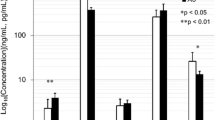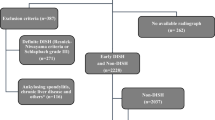Abstract
The primary objective of this study was to determine the role of fibroblast growth factor 23 (FGF-23) in the pathogenesis of diffuse idiopathic skeletal hyperostosis (DISH). A total of 61 patients with DISH and 61 age- and sex-matched control patients without DISH were included in this study. The serum FGF-23, creatinine, inorganic phosphate, calcium, albumin, albumin-adjusted calcium and alkaline phosphatase, and C-reactive protein were assessed in both groups. Based on the extent of ossification, DISH group was further divided into T-DISH and L-DISH subgroups. Data were comparatively analyzed between DISH and Non-DISH groups and among T-DISH, L-DISH, and Non-DISH groups, respectively. Besides, the number of ossification segments of all DISH patients was quantified and the correlation between the number of ossification segments and the serum concentration of FGF-23 was analyzed. The results revealed that serum FGF-23 was significantly higher in DISH group than in Non-DISH group, regardless of gender. Interestingly, serum Pi was significantly lower in DISH group than in Non-DISH group. Moreover, a significant difference in serum FGF-23 among T-DISH, L-DISH, and Non-DISH groups was also observed. In contrast to Non-DISH group, both T-DISH and L-DISH subgroups displayed significantly higher serum FGF-23 level. Although the mean value was relatively higher in L-DISH subgroup, no statistically significant difference was found between T-DISH and L-DISH subgroups. In addition, a moderately positive correlation was identified between the number of ossification segments and the serum level of FGF-23. It can be concluded that serum FGF-23 could serve as a positive biomarker for DISH and may play a significant role in ectopic ossification in DISH.


Similar content being viewed by others
Data Availability
The datasets generated during and/or analyzed during the current study are not publicly available but are available from the corresponding author on reasonable request.
References
Resnick D, Niwayama G (1976) Radiographic and pathologic features of spinal involvement in diffuse idiopathic skeletal hyperostosis (DISH). Radiology 119 (3):559–568
Mader R, Verlaan JJ, Buskila D (2013) Diffuse idiopathic skeletal hyperostosis: clinical features and pathogenic mechanisms. Nat Rev Rheumatol 9 (12):741–750
Kuperus JS et al (2017) Classification criteria for diffuse idiopathic skeletal hyperostosis: a lack of consensus. Rheumatology (Oxford) 56 (7):1123–1134
Kim SK et al (2004) The prevalence of diffuse idiopathic skeletal hyperostosis in Korea. J Rheumatol 31 (10):2032–2035
Westerveld LA et al (2008) The prevalence of diffuse idiopathic skeletal hyperostosis in an outpatient population in The Netherlands. J Rheumatol 35 (8):1635–1638
Holton KF et al (2011) Diffuse idiopathic skeletal hyperostosis and its relation to back pain among older men: the MrOS Study. Semin Arthritis Rheum 41 (2):131–138
Fournier DE et al (2020) Dystrophic calcification and heterotopic ossification in fibrocartilaginous tissues of the spine in diffuse idiopathic skeletal hyperostosis (DISH). Bone Res 8:16
Fujimori T et al (2016) Prevalence, concomitance, and distribution of ossification of the spinal ligaments: results of whole spine CT scans in 1500 Japanese patients. Spine (Phila Pa 1976) 41 (21):1668–1676
Senolt L et al (2012) Low circulating Dickkopf-1 and its link with severity of spinal involvement in diffuse idiopathic skeletal hyperostosis. Ann Rheum Dis 71 (1):71–74
Niu CC et al (2017) Correlation of blood bone turnover biomarkers and Wnt signaling antagonists with AS, DISH, OPLL, and OYL. BMC Musculoskelet Disord 18 (1):61
Mader R et al (2018) Serum adiponectin levels in patients with diffuse idiopathic skeletal hyperostosis (DISH). Clin Rheumatol 37 (10):2839–2845
Fassio A et al (2021) Diffuse idiopathic skeletal hyperostosis (DISH) in type 2 diabetes: a new imaging possibility and a new biomarker. Calcif Tissue Int 108 (2):231–239
Stubbs J, Liu S, Quarles LD (2007) Role of fibroblast growth factor 23 in phosphate homeostasis and pathogenesis of disordered mineral metabolism in chronic kidney disease. Semin Dial 20 (4):302–308
Gonciulea AR, De Beur SMJ (2017) Fibroblast growth factor 23-mediated bone disease. Endocrinol Metab Clin North Am 46 (1):19–39
Kinoshita S, Kawai M (2016) The FGF23/KLOTHO regulatory network and its roles in human disorders. Vitam Horm 101:151–174
Kawaguchi Y et al (2019) Increase of the serum FGF-23 in ossification of the posterior longitudinal ligament. Global Spine J 9 (5):492–498
Jüppner H (2011) Phosphate and FGF-23. Kidney Int 79:S24–S27
Inoue Y et al (2005) Role of the vitamin D receptor in FGF23 action on phosphate metabolism. Biochem J 390 (Pt 1):325–331
Kawaguchi Y et al (2022) Serum periostin level reflects progression of ossification of the posterior longitudinal ligament. JB JS Open Access 7 (1):e21.00111
Uehara M et al (2019) Impact of diffuse idiopathic skeletal hyperostosis on sagittal spinal alignment in the general elderly population: a Japanese cohort survey randomly sampled from a basic resident registry. JB JS Open Access 4 (3):e0062.1-6
Kawaguchi Y et al (2017) Serum biomarkers in patients with ossification of the posterior longitudinal ligament (OPLL): inflammation in OPLL. PLoS ONE 12 (5):e0174881
Law MM et al (2021) Misclassification of calcium status in end-stage kidney disease using albumin-adjusted calcium levels. Nephrology (Carlton) 26 (9):725–732
Yamashita T, Yoshioka M, Itoh N (2000) Identification of a novel fibroblast growth factor, FGF-23, preferentially expressed in the ventrolateral thalamic nucleus of the brain. Biochem Biophys Res Commun 277 (2):494–498
Itoh N (2010) Hormone-like (endocrine) FGFs: their evolutionary history and roles in development, metabolism, and disease. Cell Tissue Res 342 (1):1–11
Fukumoto S (2016) FGF23-FGF receptor/klotho pathway as a new drug target for disorders of bone and mineral metabolism. Calcif Tissue Int 98 (4):334–340
Olauson H et al (2014) New insights into the FGF23-Klotho axis. Semin Nephrol 34 (6):586–597
Hasegawa H et al (2010) Direct evidence for a causative role of FGF23 in the abnormal renal phosphate handling and vitamin D metabolism in rats with early-stage chronic kidney disease. Kidney Int 78 (10):975–980
Resnick D et al (1978) Association of diffuse idiopathic skeletal hyperostosis (DISH) and calcification and ossification of the posterior longitudinal ligament. AJR Am J Roentgenol 131 (6):1049–1053
Hiyama A et al (2018) Prevalence of diffuse idiopathic skeletal hyperostosis (DISH) assessed with whole-spine computed tomography in 1479 subjects. BMC Musculoskelet Disord 19 (1):178
Beck-Nielsen SS et al (2019) FGF23 and its role in X-linked hypophosphatemia-related morbidity. Orphanet J Rare Dis 14 (1):58
Acknowledgements
The authors thank all the patients who participated in this study and the staff from the Drum Tower Hospital, Nanjing, China.
Funding
This study was supported by the National Natural Science Foundation of China (61971216), the Key Research and Development Project of Jiangsu Province (BE2022692 and BE2020768), and the Nanjing Science and Technology Development Plan Project (202205066).
Author information
Authors and Affiliations
Contributions
HZ contributed to data collection, performed the study and data analysis, drafted the main manuscript, and provided the final approval for submission. HX contributed to data collection and performed the study and data analysis. JG contributed to data collection. XS and ZL contributed to the study design, reviewed the manuscript critically for important intellectual content, and provided the final approval for submission.
Corresponding authors
Ethics declarations
Conflict of interest
All authors have no conflicts of interest to declare.
Human and Animal Rights and Informed Consent
The study was conducted in accordance with the Declaration of Helsinki (as revised in 2013). The study was approved by our institutional review board (No. 2021-LCYJ-DBZ-05). All volunteers were fully informed about the methods, purposes, and risks involved in the study protocol and signed the informed consent. No animal studies were performed in the course of these experiments.
Consent to Participate
Informed consent was obtained from all individual participants included in the study.
Additional information
Publisher's Note
Springer Nature remains neutral with regard to jurisdictional claims in published maps and institutional affiliations.
Rights and permissions
Springer Nature or its licensor (e.g. a society or other partner) holds exclusive rights to this article under a publishing agreement with the author(s) or other rightsholder(s); author self-archiving of the accepted manuscript version of this article is solely governed by the terms of such publishing agreement and applicable law.
About this article
Cite this article
Zhou, H., Xu, H., Gong, J. et al. High Circulating FGF-23 and Its Relationship with Severity of Spinal Involvement in Diffuse Idiopathic Skeletal Hyperostosis. Calcif Tissue Int 113, 526–531 (2023). https://doi.org/10.1007/s00223-023-01134-8
Received:
Accepted:
Published:
Issue Date:
DOI: https://doi.org/10.1007/s00223-023-01134-8




